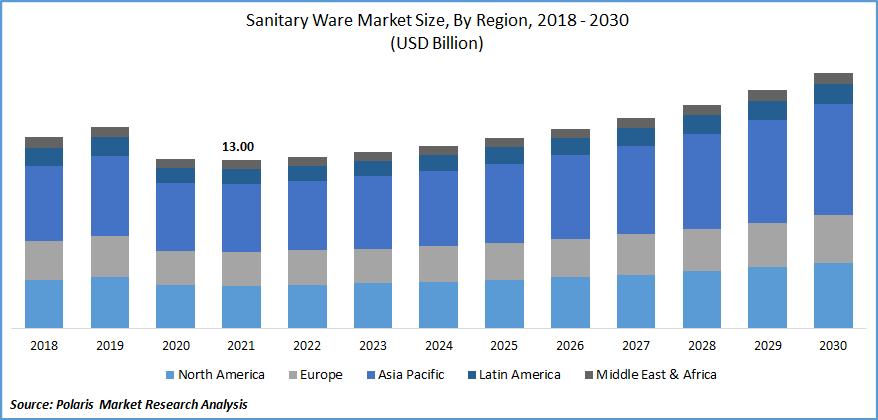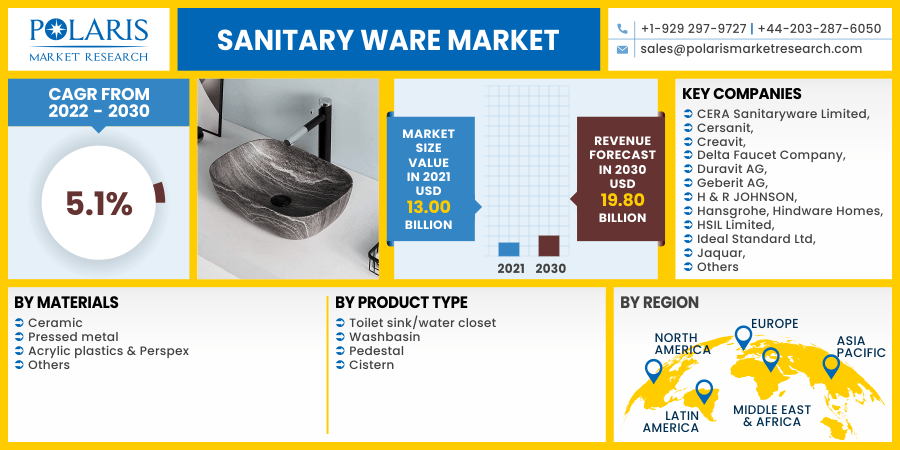
Sanitary Ware Market Share, Size, Trends, Industry Analysis Report
By Materials (Ceramic, Pressed metal, Acrylic plastics & Perspex, Others), By Product Type (Toilet sink/water closet, Wash basin, Pedestal, Cistern); By Region; Segment Forecast, 2022 - 2030
- Published Date:Feb-2022
- Pages: 110
- Format: PDF
- Report ID: PM2272
- Base Year: 2021
- Historical Data: 2018 - 2020
Report Outlook
The global sanitary ware market was valued at USD 13.00 billion in 2021 and is expected to grow at a CAGR of 5.1% during the forecast period. Sanitary ware refers to sanitary products such as water closets, washbasins, pedestals, and others. These products are generally made from ceramic, pressed metal, and other materials. The rising awareness regarding better sanitary ware products on account of various hygiene & health benefits is one of the major factors driving the market's growth globally.
 Know more about this report: request for sample pages
Know more about this report: request for sample pages
Further, the rising construction activities across the developing countries, along with the growing government initiatives for infrastructure development, are projected to propel the industry’s growth. For instance, according to the Asian Development Bank, Asia Pacific is expected to invest over USD 8-9 trillion in infrastructure development. Moreover, the government of India is planning to construct over 115,000 community toilets along with 55 million household toilets in the Swachh Bharat Mission.
The onset of the COVID-19 reflects the downfall in the industry growth owing to the slowdown in manufacturing activities. The negative impact of the virus's spread on worldwide trade, finance, and economy has hindered the sanitary ware market's growth. The pandemic halted the production of various items in the sanitary business because of the continuous lockdowns globally. The disruption in the supply chain, lockdown measures, and limited consumer spending hamper the industry development.
The negative impact of a pandemic on the end-user, such as the residential and commercial sector, is anticipated to hinder the demand for the products from this sector. However, the need for the product is projected to bounce back with high demand due to the population's growing focus towards better cleaning and proper hygiene post-COVID-19 outbreak.

Know more about this report: request for sample pages
Industry Dynamics
Growth Drivers
The global industry is primarily driven by various macroeconomic factors such as improving consumer spending power, growing economies, and rapid urbanization. The eco-friendly nature of these products made from ceramic material is anticipated to offer tremendous industry growth opportunities.
Ceramics is an eco-friendly material that can be recycled, reused, and reduced to protect the environment. Further, the increasing construction/property industry volume is expected to increase the sale of sanitary ware products globally.
The increasing demand for these products from both the residential & commercial sectors is driving the sanitary ware market growth. Both the renovation and new construction contribute to the growing demand for these products.
Further, the growing focus of the population of developing nations towards proper cleaning & hygiene is anticipated to drive the industry growth. Additionally, the government policies & measures undertaken in order to improve the sanitation facilities across the developing nations are expected to boost the demand for sanitary products.
Report Segmentation
The market is primarily segmented on the basis of materials, product type, and region.
|
By Materials |
By Product Type |
By Region |
|
|
|
Know more about this report: request for sample pages
Insight by Material
The Ceramic segment is recorded to hold the larger share in 2021 and is expected to lead the industry in the forecasting years. Ceramic is majorly known for its high durability and complex nature. The formability of the material makes it suitable for various products.
Further, ceramic is one of the highest hygiene standards for its smooth & easy to clean surface. Thus, various strong chemical acids and cleaning fluids barely affect this material.
The properties of the ceramic material, such as its pleasing appearance and versatility, along with the eco-friendly nature of the material, make it the most appropriate material used to manufacture these products. These vast benefits offered by the properties of the material are anticipated to drive the segment's growth. Moreover, the increasing per capita income of the global population is expected to drive the segment's growth.
The pressed metal segment is projected to show a progressive growth rate in the forecasting years. The segment's growth can be attributed to the benefits of these products made by pressed metal, such as low price and high durability compared to acrylic materials. Further, products made by this material usually maintain their looks over a longer period and are also thought to be more hygienic as the surface does not harbor germs.
Geographic Overview
Geographically, Asia Pacific garnered the most significant market shares in the global industry in 2021 and is expected to lead the industry over the forecast period. The nations such as South Korea, India, Japan, and China primarily attribute to industry growth.
The increasing number of sanitary ware manufacturing firms and the growing population across the region are amplifying the market's growth. Furthermore, the rising infrastructural developments in the region are anticipated to provide tremendous market growth opportunities.
The region shows stable growth in the approaching period. The regional market was showing a slight down-fall because of the onset of COVID-19. However, the rising demand and growing focus of the population toward hygiene is anticipated to drive the industry growth in the region.
Further, the rising construction activities coupled with the rise in the disposable income of the population are anticipated to drive the market's growth. Moreover, major key players are focusing on expanding their manufacturing capabilities in the emerging markets of Asia Pacific in order to maintain a strong position.
Moreover, North America is anticipated to exhibit a progressive CAGR over the forecast period. The rising economic growth along with substantial investments across both residential & commercial construction in North America is expected to drive the development of the market in the region. The high per capita income, along with the better living standards of the population, is anticipated to drive the market's growth. The growing investment in R&D by companies in the region in order to develop innovative products is expected to drive sanitary ware market growth.
Competitive Insight
Some of the major players operating in the global sanitary ware market include CERA Sanitaryware Limited, Cersanit, Creavit, Delta Faucet Company, Duravit AG, Geberit AG, H & R JOHNSON, Hansgrohe, Hindware Homes, HSIL Limited, Ideal Standard Ltd, Jaquar, Kohler Co, LAUFEN Bathrooms AG, Lecico Egypt, LIXIL Corporation, Roca Sanitario, S.A., Saudi Ceramics, Shanghai Aquacubic Sanitaryware Co., Ltd., TOTO LTD, and Villeroy & Boch.
Sanitary Ware Market Report Scope
|
Report Attributes |
Details |
|
Market size value in 2021 |
USD 13.00 billion |
|
Revenue forecast in 2030 |
USD 19.80 billion |
|
CAGR |
5.1% from 2022 - 2030 |
|
Base year |
2021 |
|
Historical data |
2018 - 2020 |
|
Forecast period |
2022 - 2030 |
|
Quantitative units |
Revenue in USD billion and CAGR from 2022 to 2030 |
|
Segments covered |
By Material, By Product Type, By Region |
|
Regional scope |
North America, Europe, Asia Pacific, Latin America, Middle East & Africa |
|
Key Companies |
CERA Sanitaryware Limited, Cersanit, Creavit, Delta Faucet Company, Duravit AG, Geberit AG, H & R JOHNSON, Hansgrohe, Hindware Homes, HSIL Limited, Ideal Standard Ltd, Jaquar, Kohler Co, LAUFEN Bathrooms AG, Lecico Egypt, LIXIL Corporation, Roca Sanitario, S.A., Saudi Ceramics, Shanghai Aquacubic Sanitaryware Co., Ltd., TOTO LTD, and Villeroy & Boch |
